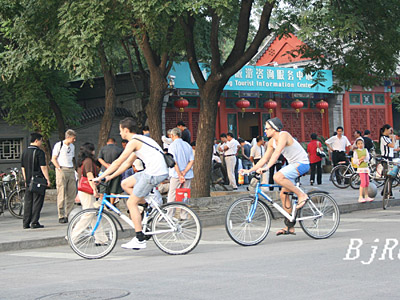
On September 22, China launched its first ever nationwide No Car Day in 108 cities as part of a Public Transport Week campaign to save energy and protect the environment.
In Beijing and other major cities across China, residents were encouraged to leave their cars at home and use buses, taxis, cycles, or simply walk instead. Some areas were open only to pedestrians, cyclists, taxis and buses from 7 am to 7 pm on No Car Day. Some 300 residents participated in a "Riding around Beijing" activity, a return to the simple art of bicycling for which Chinese cities used to be famous. "Biking is one of my favorite sports to keep fit," said Pan, the eldest cyclist of the group. "I hope everyone in Beijing will contribute a little towards the environment."
A "green wedding" was held on the same day in a restaurant in east Beijing. The bride Li, her groom Wang and their relatives and friends abandoned the conventional luxury wedding vehicles and boarded buses to reach the wedding. "Most of us have cars, but we prefer to take the bus because it's cheap, and we don't have to worry about the risk of drunk-driving," said one of the newly wed couple's friends.
Giving priority to the development of public transport is a strategy employed by the Beijing Municipal Government since last year, echoing what the State Council and Ministry of Construction have been promoting. The IC card in Beijing is considered a major achievement and a big step towards improving public transport. It was warmly welcomed by residents since the first day it was put into service -- May 10, 2006.
A further discount program has been implemented since January 1, 2007, and adults and students IC cardholders enjoy 60% off and 80% off respectively. Small wonder that by the end of August, 12 million people out of the city's 17 million were IC cardholders. Additional services such as cinema, restaurant and retail discounts will also be introduced soon.
Liu Xiaoming, Deputy Head of the Beijing Municipal Committee of Communications and a participant in "Riding around Beijing," said, "The importance of giving priority to public transport is plain to see. The Beijing Municipal Government had an additional 1.3 billion yuan (approximately $173 million) financial budget this year to subsidize the IC card discount program and other public transport infrastructure. It's a strategic measure to ease traffic jams in Beijing."
In Beijing, 200 additional buses on major routes were put into operation on No Car Day, and twenty-three new bus lines have gone into service last week according to the Beijing Public Transportation Group. Moreover 176 km of public transportation lanes have been put into use, and these will be lengthened to 250 km by the end of this year, taking the average speed of buses from 14 km/h to 20 km/h during rush hour.
"We will continue to invest more than 70 billion yuan (approximately $9.3 billion) in public transport system construction between 2006 and 2010, and 40 to 50 percent of this figure will be used in infrastructure construction," said Liu.
China's auto industry has been a key component of the nation's booming economy. Beijing's car tally hit the 3 million mark in May this year and more than 1,000 registered every day, snarling up the roads and pumping nitrogen dioxide, carbon monoxide and particulate matter into the air. China's vehicle production in July was up 32.7 percent compared to the same month last year.
Faced with such a reality, the promotion of the first ever No Car Day in China, according to Zhao Jie, Head of the Urban Traffic Study Institute of the China Academy of Urban Planning and Design, is more than a good wish. "No Car Day is just a single day of activity. The symbolic meaning of the day is far more important than its immediate effect. The key to ease congestion is to change people's transport tools. Green public transport, such as the bus, subway, taxi, and bike should be given high priorities. Right of way ought to be given to pedestrians, cyclists, public transport and private cars, in that order."
